Betelvine (Piper betel)
Piperaceae
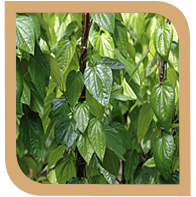 |
Plant + Climber |
Varieties
SGM 1 :
Released during 1994
Dwarf vines, low production cost, pale green colour leaves, field tolerance to wilt
No. of branches/vine - 28.31
Yield (lakhs leaves/ha/yr) - 65 ,
SGM BV 2 :
Released during 2004
Dark green leaves and less pungency
No. of branches/vine - 17-29
Yield (lakhs leaves/ha/yr) - 48.81.
Other varieties
: DPB-6, Bidhan pan.
Local type
Karpurakodi, Kallarkodi, Revesi, Karpuri, Vellaikodi, Pachaikodi, Anthiyur kodi, Kanyur kodi and Bangla type .
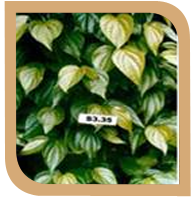 |
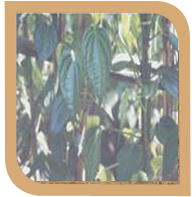 |
| SGM 1 |
SGM (BV) 2 |
Soil and climate
Well drained fertile clay loams are suitable. It does not tolerate saline and alkaline conditions. Betelvine require a cool humid with considerable humidity and regular supply of moisture in the soil is essential.
Seeds and sowing
The vines are propagated by terminal stem cutting or setts about 30 - 45 cm long. Setts obtained from the top portions of the vines are easy to root and hence best for planting. On an average 1, 00,000 setts are required for planting one hectare. Setts with vigorous apical buds and nodal adventitious roots are selected and planted at the base of the live supports, which are to be planted 4 to 5 months earlier.
| Row spacing |
Vines/hectare |
| Single vine |
Double vine |
| 20 cm |
50,000 |
1,00,000 |
| 30 cm (1 ft) |
30,000 |
60,000 |
| 45 cm (11/2 ft) |
22,500 |
45,000 |
Season
November - December and January – February are optimum for cultivation.
Preparation of field
The field is prepared to a fine tilth and beds of 2 m wide are formed to a convenient length. Provide drainage trenches of 0.5 m width by 0.5 m depth in between two adjoining beds. Plant the seeds of the live supports i.e. Agathi (Sesbania grandiflora) in long rows. About 750 banana suckers are planted at the edges of the beds, which are used, for tying the vines on the live support and for packing the betel leaf. When the Agathi plants reach 4 m height, they are topped off for maintaining the height. The crop is planted in two rows in beds of 180 cm width on Agathi plants with a spacing of 45 cm between plants in the row.
Irrigation
Irrigate the field immediately after planting and afterwards once in a week.
Aftercultivation
Training of the live standards
Before the establishment of vines, the side branches of Agathi trees upto a height of 2 m are removed for early creeping of the vines.
Training of the vines
Training is done by fixing the vine at intervals of 15 to 20 cm along the standards loosely with the help of banana fibre. Training is done at every 15 - 20 days interval depending upon the growth of vines.
Lowering of vines
Under normal cultivation, the vines grow to height of 3 m in one year period. When they reach this height their vigour to produce normal size leaf are reduced and they need rejuvenation by lowering during March - April. After the vine is lowered, the tillers spring up from the nodes at the bends of the coiled vines at the ground level and produce many primary vines. Irrigation should be given after each lowering.
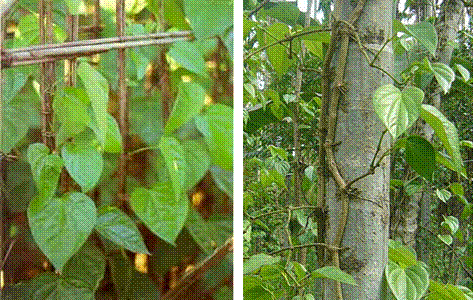 |
| Bamboo standard (left), Live standard (Right) |
Manuring
Apply 150 kg N/ha/year through Neem cake (75 kg N) and Urea (75 kg N) and 100 kg P2O5 through Super phosphate and 30 kg Muriate of potash in three split doses first at 15 days after lifting the vines and second and third dose at 40 - 45 days intervals. Apply on beds shade dried neem leaf or Calotropis leaves at 2 t/ha and cover it with mud (2 t in 2 split doses).
Time of application |
N |
P |
K |
(kg/ha) |
Basal dressing |
37.5 |
100 |
50 |
Top dressing @ 3 split doses |
112.5 |
0 |
0 |
Plant protection
Pests
Scale insects
Select scale-free seed vines. Spray Chlorpyriphos 20 EC 2 ml/lit when one or two scales are noticed on the basal portion of the stem/leaves. Direct the spray solution to the basal portion of the vines. Spray NSKE 5 % or Malathion 50 EC 1 ml/lit.
Mites (Sevvattai)
Mites can be controlled by spraying Wettable sulphur 50 WP @ 1 g/lit or Dicofol 18.5 EC 0.5 ml/lit.
Sooty mould (Aphids)
To control aphids spray Chlorpyriphos at 2 ml/lit on Agathi leaves. Clip off excess Agathi leaves.
Mealy bugs
Mealy bugs can be controlled by spraying Chlorpyriphos 20 EC at 2 ml/lit or Dimethoate 30 EC 2ml/lit. Concentrate the spray towards the collar region.
Nematode
Application of Neem cake at 1 t/ha or shade dried Calotropis leaves @ 2.5 t/ha can be applied to soil for controlling the nematode populations.
Soil application of Bacillus subtilis (BbV 57) or Pseudomonas fluorescens @ 10 g / vine for the control of root knot nematode and quick wilt of betel vine
Diseases
Phytophthora Wilt
Integrated method for the management of Phytophthora wilt.
- Select well matured (more than 1 year old) seed vines free from pest and diseases.
- Soak the seed vines for about 30 minutes in Streptocyline 500 ppm or Bordeaux mixture 0.5 %.
- Apply 150 kg N/ha/year through Neem cake (75 kg N) and Urea (75 kg N) and 100 kg P2O5 through Super phosphate and 30 kg Muriate of potash in 3 split doses first at 15 days after lifting the vines and second and third dose at 40 - 45 days intervals. Apply on beds, shade dried neem leaf or Calotropis leaves at 2 t/ha and cover it with mud (2 t in 2 split doses).
- Drench Bordeaux mixture 0.25% in basins formed around the vine at monthly intervals starting from October – January, three times soil drench and six times spray from June - July.
- During winter season avoid frequent irrigation.
- Remove the affected vines away from the garden and burn them.
- Application of Trichoderma viride @ 5 g/vine.
Bacterial leaf spot, blight and bacterial stem rot
Spray Streptocycline @ 400 ppm + Bordeaux mixture @ 0.25% at the time of first disease symptoms appear. Continue spraying at 20 days intervals. Always spray the chemical after plucking the leaves.
Anthracnose (Theechal)
Spray 0.2 % Ziram or 0.5% Bordeaux mixture after plucking the leaves after the first appearance of the symptom. The variety Karpoori is susceptible to the disease.
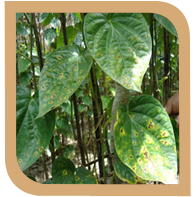 |
Symptom |
Powdery mildew
Powdery mildew can be controlled by spraying 0.2% Wettable sulphur after plucking the leaves.
Harvest
It depends upon the growth of the vines and market condition. Once harvesting starts it continues almost every day.
Yield
About 75 to 100 lakh leaves/ha/year can be obtained.
 |
 |
| Leaves |
Leaves at Market |
|







